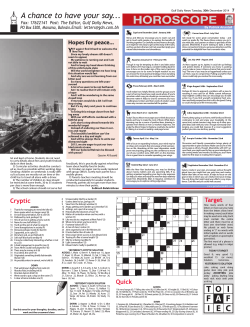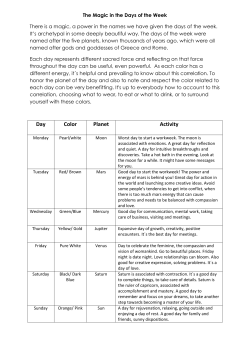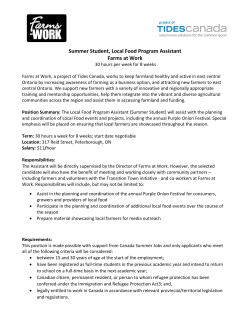
Script - Fog.ccsf.edu - City College of San Francisco
Causes of Tides – Tutorial Script In the first video tutorial of this series, we studied tidal data from many locations worldwide and learned how tides behave. In this video tutorial, we will explore the causes of that behavior. First of all, we know that most tidal waves have a period of one wave every 12 hrs and 25 minutes otherwise stated as two waves every 24 hrs and 50 minutes. What else has that same period? Earth’s rotation relative to the Moon is also 24 hours and 50 minutes. What does that mean? After the Earth has rotated once relative to the Sun – 24 hours – it has to rotate another 50 minutes to catch up with the Moon, which during that 24 hours moved 1/29th its way around its orbit around the Earth. 24 hours and 50 minutes is a lunar day. In addition, the two week cycle of neap and spring tides exactly matches the phases of the Moon as the Moon completes its orbit around the Earth. The Moon is the main agent causing tides on our planet. How? This image, which is not to scale, shows a spherical blue Earth that is being pulled to the right by a gravitational force between itself and the Moon. The side of Earth closest to the Moon has a longer arrow, representing the stronger gravitational force felt there. The arrow on the opposite side is shorter because its force is smaller. Gravitational force is stronger, the closer two objects are together and weaker, the further away they are. Why? The gravitational force experienced between any two objects is equal to a very small constant number, G, known as the Gravitational Constant, multiplied by the masses of both objects and divided by the distance between them squared. How would you make this Gravitational Force (F) or fraction greater? Increase the numerator or decrease the denominator. Increase the mass of the objects OR decrease the distance between the two objects. The force of gravity on the closer side to the Moon thus feels a stronger gravitational force than the other. What happens when there’s a differential force applied to something? If it’s fluid, it stretches out. The side pulled with greater force moves further away faster, leaving the other side lagging behind. Now let’s imagine the blue sphere is the Earth’s oceans, and let’s put the solid Earth in the middle. What results? Two bulges of water – one facing the Moon, the other on the opposite side from the Moon. And the solid Earth rotates under these bulges carrying various parts of the planet into and out of these bulges throughout the day. When you are standing under a bulge, you are experiencing a high tide. When you are between two bulges, you experience a low tide. The water has been pulled away. How does the Sun fit in? The gravitational force that’s felt between the Earth and the Sun is greater than that felt between the Earth and the Moon. But it isn’t the total force that creates the tides – it’s the difference in force felt on one side of the Earth versus the other. And the difference becomes greater the closer the two objects are to each other. This graph shows how force of gravity increases with proximity and decreases with distance. The Sun is so massive, its force is much greater than the Moon’s, even though it’s further away. But again, it’s the difference in force that creates tides. So let’s look at what happens when you move the Moon or any object further away. For the close Moon, when we take the difference between the near-side force and the far-side force, we get a force differential this large. When we move the Moon further away, we see that the near-side force and far-side forces vary less. The force differential is smaller. So the tides would be smaller. This cartoon says the same thing in a much more clever way. The Sun is a much more massive body than the Moon. However, because it is SO far away from the Earth, the differences experienced on the near and far sides are much much smaller than those produced by the Moon. We can show that more clearly in this image, which is also NOT to scale, but nonetheless it shows that there are always two bulges associated with the solar tides – one on the side facing the Sun, which is being pulled toward the Sun with a greater force – the other on the side away from the Sun, which is being pulled toward the Sun as well, but not as strongly and thus lags behind. The lunar bulges are situated similarly with respect to the Moon. Notice the difference in force (shown as differences in arrow length) are much greater for the lunar bulges than for the solar bulges (and hence the lunar tides are the dominant ones and the ones that dictate tidal period and patterns). Now we can combine the lunar-bulge model of tides with the concepts of constructive and destructive wave interference as discussed in the waves video tutorials to explain the periodicity of spring and neap tides. The lunar and solar bulges are continually interfering with each other. As the Moon moves around the Earth, every 29 days, it will carry the lunar bulges into phase and out of phase with the solar bulges. When the two are in phase, 1 which happens during full and new Moons, the two bulges constructively interfere, and we experience a much greater tidal range with lower lows and higher highs: spring tides. When the two bulges are out of phase, which happens when we see half-Moons, the interference is destructive and the tidal range is at its lowest, the lows aren’t so low – the highs aren’t so high: neap tides. Turns out we can walk outside at night, look up into the night sky, and based on the phase of the Moon determine whether we’re experiencing neap or spring tides. Pause now. Let’s return now to the concepts of tidal period and lunar day as discussed at the start of this tutorial. How does lunar day impact the way we experience tides? This picture shows the Earth’s rotation from the point of view of the North Star, Polaris, looking down. Notice the stick figure that is starting under one of the bulges – experiencing high tide – on the side of the Earth facing the Moon. 6 hours and 12 and ½ minutes later that figure has rotated out of the high tide. Ebb current has removed water from the land, and low tide has arrived. Then flood current starts as the figure heads into another high tide at 12 hours and 25 minutes. 18 hours and 37.5 minutes later, the figure has left the high tide and is experiencing low tide again. 24 hours later the figure is back where it started relative to the Sun BUT, the Moon has been moving during Earth’s rotation. The Moon has moved 1/29th of its full orbit. The bulges have moved with it. So the figure needs to rotate another 50 minutes to meet back up with the bulge. And that’s why we experience two high tides and two low tides every 24 hours and 50 minutes. OR, more precisely, the period of one wave is 12 hours and 25 minutes. Pause now. How do we use the tidal-bulge model to explain the variety of tidal patterns we find across the globe? This picture reminds us that while the Earth is orbiting the Sun and rotating through the lunar bulges, it is tilted at a 23.5-degree angle. So if we are at the equator, we will rotate through two bulges of roughly the same water level and experience semidiurnal tides. If we are at the midlatitudes, however, we will move through the two bulges, but different parts of them with different water levels. Thus we experience semidiurnal mixed tides. At the poles, we miss one bulge entirely, so we rotate through only one bulge per day and experience a diurnal pattern. How does Earth’s orbit around the Sun affect the tides? Because the Sun’s orbit is actually an ellipse, in January the Earth is a little closer to the Sun than the rest of the year. Remember this cartoon? Imagine it’s the Sun that’s coming closer. What do we get? Greater force differential, so bigger solar bulges. And bigger solar bulges means greater interference with the lunar bulges – more constructive interference when they’re in phase and more destructive interference when they’re out of phase. The Spring Tides would have an even greater tidal range, and the Neap Tides and even smaller one. Now, it’s all very well to say that the bulges stay in place and the Earth rotates under them. But we know that the oceans are confined to basins and water doesn’t hop over the continents as the planet rotates. How do ocean basins impact tidal behavior? This image shows the Earth with a cut-out ocean basin. Since the bulges of water are confined to these basins, they are forced to slosh back and forth as the Earth rotates relative to the Moon. In the northern hemisphere, as this water sloshes westward, it is deflected to its right by the coriolis effect, which means it sloshes west and north where it hits and moves along the northern edge of the basin until it hits the western boundary, where it’s then forced southward along the edge of that boundary. As it sloshes back eastward, it is again deflected right, which means it sloshes up and along the southern edge of its basin. Combined together, this sloshing around the edges of the basin creates a rotary wave with a 12 hr and 25-minute period much like water sloshing around the outside of a bucket: counterclockwise in the Northern Hemisphere and clockwise in the Southern Hemisphere. We call each ocean basin around which tides slosh, an amphidromic system. In the center of each bucket of sloshing water, there’s a point where the water level doesn’t change. We call that the amphidromic point. Around the amphidromic point, the tides rotate once every 12 hours and 25 minutes. This cross-section through the amphidromic system points out what the sloshing looks like from the side at two moments in time: one where one side has water sloshing up – high tide – and the other water sloshing away – low tide; and then the opposite. 2 Notice that the tidal range increases as we move away from the amphidromic point. So where in this image would you expect to find the largest tidal range? As far away from the amphidromic point as you can get. In this birds-eye map view, we can further describe the amphidromic system with lines and circles. These lines that look like spokes of a wheel represent the location of the high tide every hour as it moves around the bucket. We call these lines cotidal lines because every location along the line experiences high tide or low tide at the same time. The concentric circles are called corange lines because everywhere along each circle, locations are equidistant from the center of the bucket, the amphidromic point, and therefore they experience the same difference between high tide and low tide, or the same tidal range. Let’s look more closely at actual data of amphidromic systems from across the world’s oceans. Notice this system in the Northern Hemisphere off the coast of California. First, we see that the tides’ rotary motion isn’t always moving at the same speed. How do we know? Cotidal lines are sometimes close together; other times much further apart. Why the difference in speed? As we discussed in the waves video tutorials, waves speed up in deeper water and slow down in shallower water. So the speed of the tidal waves here are telling us something about the depth of the water. We also see that due to the counter clockwise movement of tides in this system, the tides move up the coast of California northward. So if you have a friend in L.A., and she says that the high tide has just arrived at her beach, then you can expect it to arrive at Ocean Beach off San Francisco about 2 hours later. Areas with the largest tidal range can be found further away from amphidromic points, and those with the least tidal range are closest to them. There are many amphidromic systems across the world’s oceans, produced by the varying shapes of the ocean basins and the configuration of continents and islands. Let’s piece together again how you would draw an idealized amphidromic system in a square ocean basin in the Northern Hemisphere. First you’d start by creating the spokes of your wheel, the cotidal lines, all coming out from the amphidromic point center. Be sure to include enough to get a divisor of 12. Then we can pick a starting point for our wave and demonstrate how it moves counterclockwise, in this case jumping 2 hours for each spoke until we get back where we started, 12 hours and 25 minutes later. Next we add the corange lines as concentric circles. And we label them with increasing tidal ranges as we move outward from the amphidromic point. Pause now. For more information and more detail, continue on to the next video in this series. [End credits] Tides Series: Part 1. Tidal Patterns Part 2: Causes of Tides Part 3: Living with the Tides Causes of Tides Geoscience Video Tutorial Produced by Katryn Wiese City College of San Francisco Copyright: Creative Commons: Attribution – Noncommercial – Share Alike 3.0 All media produced by Katryn Wiese unless indicated below: *Intro and exit music: used with permission © Alexis Harte *Review music: used with permission © Proceed With Caution *Moon rise on beach – title slide – Seb Ruiz – CC BY-NC-SA 2.0 *Earth-Moon orbit as seen from space (NASA) *Rotating Earth through one lunar day with rising and falling water levels – NOAA *Moon phases -- NASA 3 *Earth-Moon-Sun orbits – NOAA *Tide cartoon – Safely Endangered © – Used with permission *Animated tidal bulges/forcing – The Comet Program © -- NASA and www.meted.ucar.edu *Phases of the Moon animation on Moon face – Tomruen – Public Domain *Satellite map of Earth as a globe (used in animation to show from north pole) – Google Earth – Image: Landsat and IBCAO; Data: SIO, NOAA, US Navy, GNGA, GEBCO *Tidal bulges relative to Earth-Moon declination – NOAA *Tidal patterns of diurnal, mixed, semidurnal – NOAA *Annual cycle of Earth-Moon-Sun System – The Comet Program © -- NASA and www.meted.ucar.edu *Amphidromic systems from above and the side – American Meteorological Society © *Global amphidromic map of world’s oceans – NASA and TVGSFC 4
© Copyright 2025









